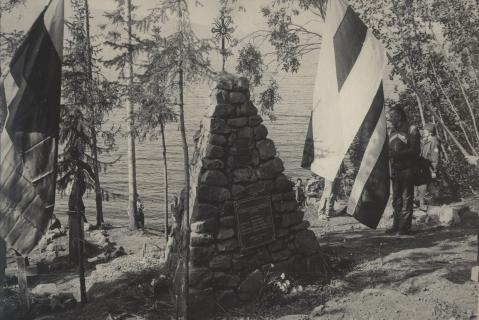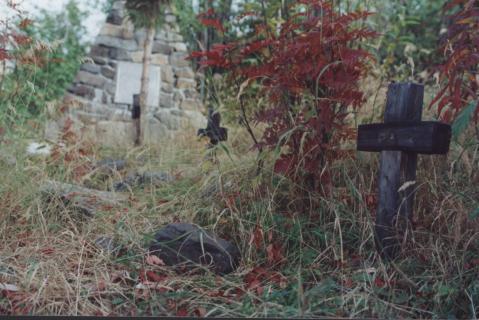In the 1940s a special camp outpost of Norillag was located at Lake Lama. From 1941 to 1947 senior artillery officers from the three Baltic states were imprisoned here in strict secrecy (14 officers from Lithuania, 13 from Latvia and 15 from Estonia). Fifteen died in captivity: all but one starved to death in winter 1941/1942. Those who died were buried in individual graves and a headboard and marker was placed on each.
During the 1960s a Pioneer camp for the young and the Lama sanatorium were located where the camp outpost formerly stood. Neither the camp nor the burials have survived to the present. In 1966 former camp inmate I.T. Sidorov placed a memorial on the site of the camp burial ground at the request of Major Harald Roots (Estonia). The inscription reads, “Here lie buried those who died of scurvy during the harsh years of war, 1941-1942” and lists the names of ten prisoners whom he could recall.
In 1989-1990 the burial ground was visited by expeditions from Lithuania, Latvia and Estonia. In 1990 the Lithuanian expedition erected a fretwork wooden cross where the first monument stood and a head-board which reads, in Lithuanian and Russian, “1941-1944. Here by Lake Lama are buried Lithuania’s artillery officers who without investigation or trial were exiled by Stalin’s butchers”. I.T. Sidorov’s memorial was dismantled and taken to the War Museum in Kaunas. In July-August 1990 the members of a combined Baltic expedition “Lama-90” erected a three-sided pyramid 2.3 metres high made up of fragments of basalt (designer R. Svidinskas). Surmounted by a brass cross, each side bears a plaque with the names of those who died and the national emblems of Latvia, Estonia and Lithuania.
A Book in Remembrance of the Victims of Political Repression in the Krasnoyarsk Krai (13 vols. 2004-2014) includes biographical entries for 45,400 who were shot or sent to the camps.
The Memorial online database (2025) includes 55,742 victims in the Krasnoyarsk Krai (Region). See Yeniseisk.
30,000 were sent to camps or special settlements elsewhere. Drawing on other sources, however, the database lists more than 12,000 sent to the the Krasnoyarsk Region, some to its camps (1,017), most to its special settlements (11,000).
| Date | Nature of ceremonies | Organiser or responsible person | Participants | Frequency |
|---|---|---|---|---|
|
nk
|
commemorative masses
|
nk
|
nk
|
from time to time
|
| State of burials | Area | Boundaries |
|---|---|---|
|
The grave of Colonel J Jumerts (Latvia) has survived; it is marked by a stone
|
not determined
|
not delineated
|
[ original texts and hyperlinks ]
Archive of the War Museum (Kaunas)
Reply № 012-2981 (dated 2 July 2014) from the Norilsk City Administration to a formal enquiry by RIC Memorial (St Petersburg)




